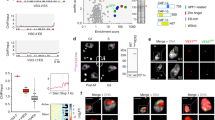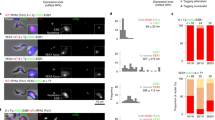Abstract
Trypanosoma brucei is the causative agent of African sleeping sickness in humans and one of the causes of nagana in cattle. This protozoan parasite evades the host immune system by antigenic variation, a periodic switching of its variant surface glycoprotein (VSG) coat. VSG switching is spontaneous and occurs at a rate of about 10-2–10-3 per population doubling in recent isolates from nature, but at a markedly reduced rate (10-5–10-6) in laboratory-adapted strains1,2,3. VSG switching is thought to occur predominantly through gene conversion, a form of homologous recombination initiated by a DNA lesion that is used by other pathogens (for example, Candida albicans, Borrelia sp. and Neisseria gonorrhoeae) to generate surface protein diversity, and by B lymphocytes of the vertebrate immune system to generate antibody diversity. Very little is known about the molecular mechanism of VSG switching in T. brucei. Here we demonstrate that the introduction of a DNA double-stranded break (DSB) adjacent to the ∼70-base-pair (bp) repeats upstream of the transcribed VSG gene increases switching in vitro ∼250-fold, producing switched clones with a frequency and features similar to those generated early in an infection. We were also able to detect spontaneous DSBs within the 70-bp repeats upstream of the actively transcribed VSG gene, indicating that a DSB is a natural intermediate of VSG gene conversion and that VSG switching is the result of the resolution of this DSB by break-induced replication.
This is a preview of subscription content, access via your institution
Access options
Subscribe to this journal
Receive 51 print issues and online access
$199.00 per year
only $3.90 per issue
Buy this article
- Purchase on Springer Link
- Instant access to full article PDF
Prices may be subject to local taxes which are calculated during checkout




Similar content being viewed by others
References
Horn, D. & Cross, G. A. M. Analysis of Trypanosoma brucei vsg expression site switching in vitro . Mol. Biochem. Parasitol. 84, 189–201 (1997)
Robinson, N. P., Burman, N., Melville, S. E. & Barry, J. D. Predominance of duplicative VSG gene conversion in antigenic variation in African trypanosomes. Mol. Cell. Biol. 19, 5839–5846 (1999)
Turner, C. M. The rate of antigenic variation in fly-transmitted and syringe-passaged infections of Trypanosoma brucei . FEMS Microbiol. Lett. 153, 227–231 (1997)
Berriman, M. et al. The genome of the African trypanosome Trypanosoma brucei . Science 309, 416–422 (2005)
de Lange, T. & Borst, P. Genomic environment of the expression-linked extra copies of genes for surface antigens of Trypanosoma brucei resembles the end of a chromosome. Nature 299, 451–453 (1982)
Hertz-Fowler, C. et al. Telomeric expression sites are highly conserved in Trypanosoma brucei . PLoS ONE 3, e3527 (2008)
Bernards, A. et al. Activation of trypanosome surface glycoprotein genes involves a duplication-transposition leading to an altered 3′ end. Cell 27, 497–505 (1981)
Hoeijmakers, J. H., Frasch, A. C., Bernards, A., Borst, P. & Cross, G. A. M. Novel expression-linked copies of the genes for variant surface antigens in trypanosomes. Nature 284, 78–80 (1980)
Horn, D. The molecular control of antigenic variation in Trypanosoma brucei . Curr. Mol. Med. 4, 563–576 (2004)
Barry, J. D. & McCulloch, R. Antigenic variation in trypanosomes: enhanced phenotypic variation in a eukaryotic parasite. Adv. Parasitol. 49, 1–70 (2001)
Borst, P. & Ulbert, S. Control of VSG gene expression sites. Mol. Biochem. Parasitol. 114, 17–27 (2001)
Taylor, J. E. & Rudenko, G. Switching trypanosome coats: what’s in the wardrobe? Trends Genet. 22, 614–620 (2006)
Glover, L., Alsford, S., Beattie, C. & Horn, D. Deletion of a trypanosome telomere leads to loss of silencing and progressive loss of terminal DNA in the absence of cell cycle arrest. Nucleic Acids Res. 35, 872–880 (2007)
Glover, L., McCulloch, R. & Horn, D. Sequence homology and microhomology dominate chromosomal double-strand break repair in African trypanosomes. Nucleic Acids Res. 36, 2608–2618 (2008)
Haber, J. E. Transpositions and translocations induced by site-specific double-strand breaks in budding yeast. DNA Repair (Amst.) 5, 998–1009 (2006)
Zarrin, A. A. et al. Antibody class switching mediated by yeast endonuclease-generated DNA breaks. Science 315, 377–381 (2007)
Llorente, B., Smith, C. E. & Symington, L. S. Break-induced replication: what is it and what is it for? Cell Cycle 7, 859–864 (2008)
Barzel, A. & Kupiec, M. Finding a match: how do homologous sequences get together for recombination? Nature Rev. Genet. 9, 27–37 (2008)
de Lange, T., Kooter, J. M., Luirink, J. & Borst, P. Transcription of a transposed trypanosome surface antigen gene starts upstream of the transposed segment. EMBO J. 4, 3299–3306 (1985)
McCulloch, R., Rudenko, G. & Borst, P. Gene conversions mediating antigenic variation in Trypanosoma brucei can occur in variant surface glycoprotein expression sites lacking 70-base-pair repeat sequences. Mol. Cell. Biol. 17, 833–843 (1997)
Morrison, L. J., Majiwa, P., Read, A. F. & Barry, J. D. Probabilistic order in antigenic variation of Trypanosoma brucei . Int. J. Parasitol. 35, 961–972 (2005)
Marcello, L. & Barry, J. D. Analysis of the VSG gene silent archive in Trypanosoma brucei reveals that mosaic gene expression is prominent in antigenic variation and is favored by archive substructure. Genome Res. 17, 1344–1352 (2007)
Dreesen, O. & Cross, G. A. M. Consequences of telomere shortening at an active VSG expression site in telomerase-deficient Trypanosoma brucei . Eukaryot. Cell 5, 2114–2119 (2006)
Dreesen, O., Li, B. & Cross, G. A. M. Telomere structure and function in trypanosomes: a proposal. Nature Rev. Microbiol. 5, 70–75 (2007)
Ohshima, K., Kang, S., Larson, J. E. & Wells, R. D. TTA.TAA triplet repeats in plasmids form a non-H bonded structure. J. Biol. Chem. 271, 16784–16791 (1996)
Hirumi, H. & Hirumi, K. Continuous cultivation of Trypanosoma brucei blood stream forms in a medium containing a low concentration of serum protein without feeder cell layers. J. Parasitol. 75, 985–989 (1989)
Wirtz, E., Leal, S., Ochatt, C. & Cross, G. A. M. A tightly regulated inducible expression system for conditional gene knock-outs and dominant-negative genetics in Trypanosoma brucei . Mol. Biochem. Parasitol. 99, 89–101 (1999)
Dreesen, O. & Cross, G. A. M. Telomerase-independent stabilization of short telomeres in Trypanosoma brucei . Mol. Cell. Biol. 26, 4911–4919 (2006)
Schrader, C. E., Linehan, E. K., Mochegova, S. N., Woodland, R. T. & Stavnezer, J. Inducible DNA breaks in Ig S regions are dependent on AID and UNG. J. Exp. Med. 202, 561–568 (2005)
Schlissel, M. S. & Baltimore, D. Activation of immunoglobulin kappa gene rearrangement correlates with induction of germline kappa gene transcription. Cell 58, 1001–1007 (1989)
Acknowledgements
This work was supported by awards from the C. H. Revson Foundation (to C.E.B.), the German National Academic Foundation (to K.I.L.), the Otto Ritter Foundation (to K.I.L.), the W. M. Keck Foundation (to F.N.P.), the Irma T. Hirschl Foundation (to F.N.P.) and by grant number R01AI021729 from the National Institute of Allergy and Infectious Diseases of the US National Institutes of Health (to G.A.M.C.). The content is solely the responsibility of the authors and does not necessarily represent the official views of the NIAID or the NIH.
Author Contributions All authors conceived of and designed the experiments. C.E.B. and T.L. are primarily responsible for the experiments shown in Fig. 1. C.E.B. and O.D. are primarily responsible for the experiments shown in Figs 2 and 3. F.N.P. is primarily responsible for the experiments in Fig. 4. C.E.B., O.D., G.A.M.C. and F.N.P. wrote the manuscript.
Author information
Authors and Affiliations
Corresponding author
Supplementary information
Supplementary Information
This file contains Supplementary Figures S1-S3 and Supplementary Table S1. (PDF 497 kb)
Rights and permissions
About this article
Cite this article
Boothroyd, C., Dreesen, O., Leonova, T. et al. A yeast-endonuclease-generated DNA break induces antigenic switching in Trypanosoma brucei. Nature 459, 278–281 (2009). https://doi.org/10.1038/nature07982
Received:
Accepted:
Published:
Issue Date:
DOI: https://doi.org/10.1038/nature07982
This article is cited by
-
Decoding the impact of nuclear organization on antigenic variation in parasites
Nature Microbiology (2023)
-
Identification of a small-molecule inhibitor that selectively blocks DNA-binding by Trypanosoma brucei replication protein A1
Nature Communications (2023)
-
Variant antigen diversity in Trypanosoma vivax is not driven by recombination
Nature Communications (2020)
-
Genomic comparison of Trypanosoma conorhini and Trypanosoma rangeli to Trypanosoma cruzi strains of high and low virulence
BMC Genomics (2018)
-
Inducible high-efficiency CRISPR-Cas9-targeted gene editing and precision base editing in African trypanosomes
Scientific Reports (2018)
Comments
By submitting a comment you agree to abide by our Terms and Community Guidelines. If you find something abusive or that does not comply with our terms or guidelines please flag it as inappropriate.



